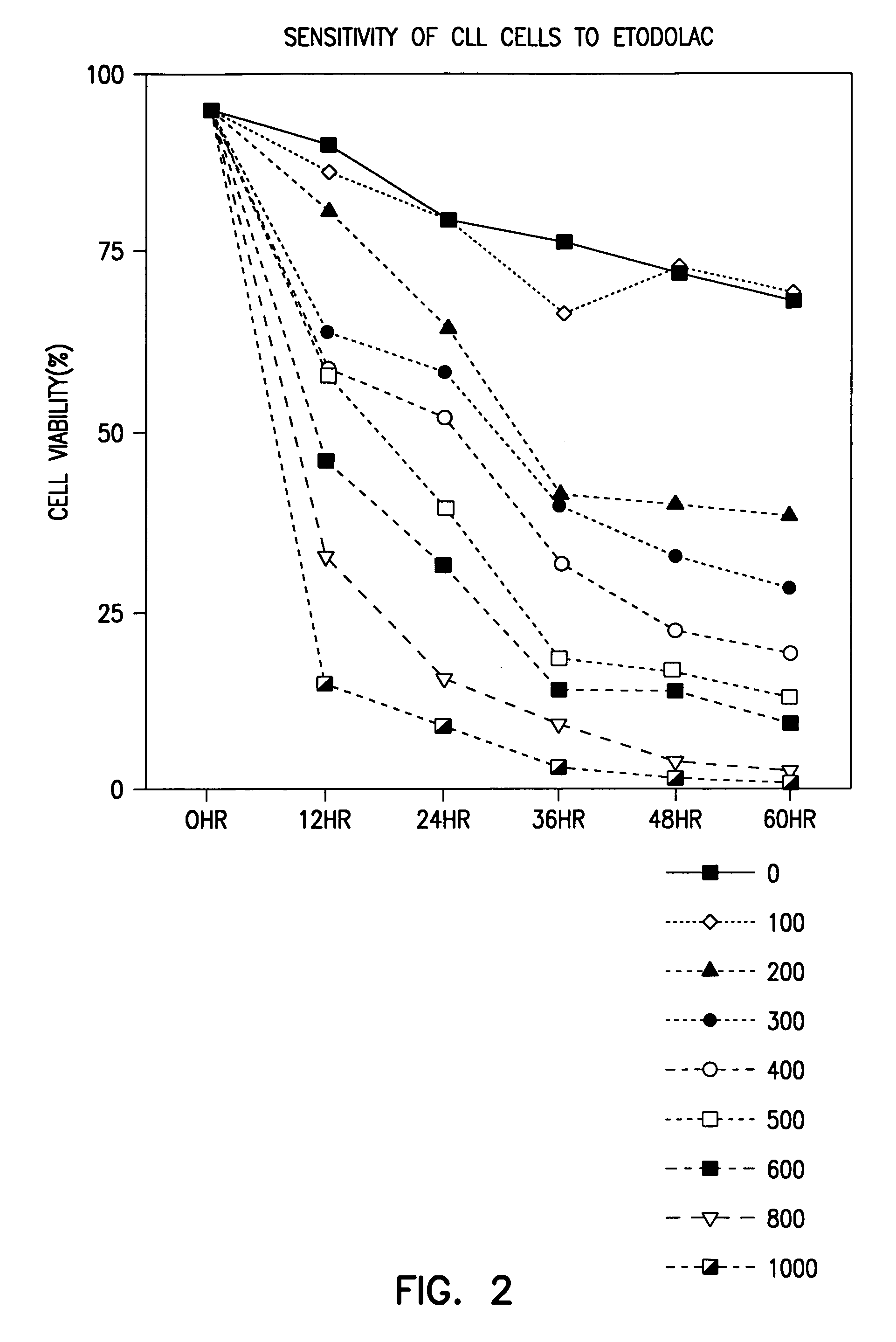Use of etodolac in the treatment of multiple myeloma
- Summary
- Abstract
- Description
- Claims
- Application Information
AI Technical Summary
Benefits of technology
Problems solved by technology
Method used
Image
Examples
example 1
Sensitivity of Normal Peripheral Blood Lymphocytes and CLL Cells to Etodolac
[0050]Mononuclear cells were isolated from the peripheral blood of B-CLL patients and normal donors using density gradient centrifugation (Ficoll-Paque). Cells were cultured at 2×106 cells per mL in RPMI with 20% autologous plasma in 96-well plates with or without the indicated μM concentrations of etodolac (racemic, S-etodolac, R-etodolac) and in combination with 2-chloro-2′-deoxyadenosine (2CdA) or fludarabine. At indicated times (12, 24, 36, 48, 60, 72 hours), viability assays were performed using the erythrocin B exclusion assay, as described by D. Carson et al., PNAS ISA, 89, 2970 (1992).
[0051]As shown in FIG. 1, significant death of normal PBLs occurred only at 800 μM racemic etodolac, a concentration which cannot be obtained in vivo.
[0052]Peripheral blood lymphocytes from a normal donor were cultured with 1.0 mM etodolac for 24 hours. Then B lymphocytes were identified by staining with anti-CD19 antib...
example 2
Synergistic Combinations of Etodolac and Chemotherapeutic Agents
[0053]Fludarabine is a nucleoside analog commonly used for the treatment of CLL. In this experiment the in vitro survival of CLL cells at the indicated time points was compared in cultures containing medium alone (“Con”, squares), fludarabine 10 nM (diamonds), etodolac 10 μM (closed circles), and fludarabine 10 nM plus etodolac 10 μM (open circles). The two drugs together exhibited a synergistic cytotoxic effect. FIG. 3 shows that the combination killed 50% of CLL cells during 48 hours of culture, while either drug alone was ineffective. FIG. 4 demonstrates synergy between 50 μM etodolac and 10 nM 2-chlorodeoxyadenosine and fludarabine, under the same test conditions.
example 3
Effect of R(−) and S(+) Etodolac Against CLL Cells
[0054]Etodolac tablets were ground in a mortar and extracted from the formulation using ethyl acetate. The resulting racemic mixture of enantiomers was separated into R and S isomers on a preparative scale by fractional crystallization by the procedure of Becker-Scharfenkamp and Blaschke, J. Chromatog., 621, 199 (1993). Thus, the racemic mixture solid was dissolved in absolute 2-propanol and S-1-phenylethylamine was added to the solution. The resulting salt solution was stored in the refrigerator for 4 days. The crystalline white salt product was filtered and washed with cold 2-propanol and recrystallized two more times from 2-propanol. The same procedure was repeated for the R isomer only using R-1-phenylethylamine as the resolving agent. Finally, the R and S salts were decomposed using 10% sulfuric acid (v / v) and extracted with ethyl acetate. The chiral purity of each isomer was verified by HPLC using a Chiral-AGP column from Chrom...
PUM
| Property | Measurement | Unit |
|---|---|---|
| Mass | aaaaa | aaaaa |
| Molar density | aaaaa | aaaaa |
| Molar density | aaaaa | aaaaa |
Abstract
Description
Claims
Application Information
 Login to View More
Login to View More - R&D
- Intellectual Property
- Life Sciences
- Materials
- Tech Scout
- Unparalleled Data Quality
- Higher Quality Content
- 60% Fewer Hallucinations
Browse by: Latest US Patents, China's latest patents, Technical Efficacy Thesaurus, Application Domain, Technology Topic, Popular Technical Reports.
© 2025 PatSnap. All rights reserved.Legal|Privacy policy|Modern Slavery Act Transparency Statement|Sitemap|About US| Contact US: help@patsnap.com



